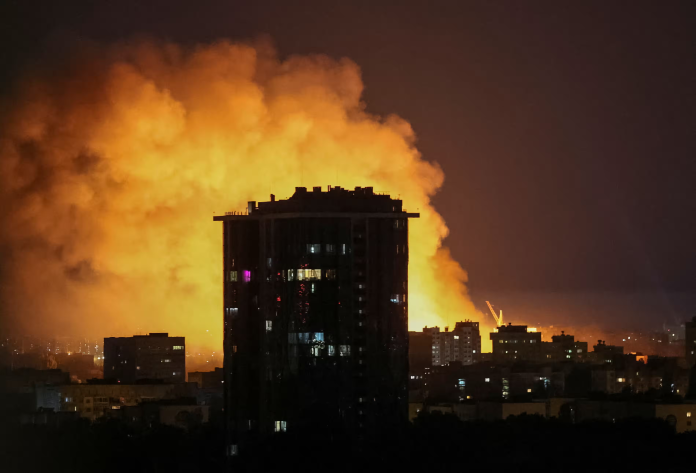On the night of 4 July, Russian troops launched a powerful combined strike on Kyiv using missiles and drones, targeting Ukraine’s air defence systems, according to Ukrainian media.
The air raid alert reportedly lasted more than eight hours, with Russia launching a total of 539 drones and 11 missiles at Ukrainian territory, according to the Ukrainian Air Force.
“The main target of the strikes was the capital of Ukraine, the city of Kyiv!” the Air Force reported.
The Ukrainian state railway company Ukrzaliznytsia (Ukrainian Railways) reported that the attack on Kyiv damaged the railway infrastructure. Russian shells also hit industrial facilities, with high concentrations of smoke detected in the air, prompting the Kyiv authorities to urge residents to close their windows.
According to Ukrainian military experts, Russian Kh-47M2 Kinzhal (Dagger) and Iskander missiles struck Kyiv first. After the missiles depleted the Ukrainian capital’s air defence systems, Russian troops launched Geran drones. As a result of the strikes, Patriot air defence batteries at Kyiv’s Zhuliany and Boryspil airports were hit.
Washington’s decision earlier this week to halt deliveries of some critical weapons to Ukraine prompted warnings from Kyiv that the move would weaken its ability to defend itself against intensifying air strikes and advances on the battlefield. Ukrainian President Volodymyr Zelensky said on Thursday that he hoped to speak with his US counterpart Donald Trump on Friday about US arms supplies.
Cost of survival
The search for replacements for lost air defence systems, particularly the high-end Patriot batteries, has led to fraught negotiations. As reported by Bild, German authorities are now engaged in talks with Washington over a fundamental shift in the model of military aid.
This move signals the end of large-scale, grant-based military aid from the US under the Presidential Drawdown Authority (PDA), acknowledging depleted US stocks and a desire to offload financial responsibility onto European allies while maintaining US defence industry revenue.
The financial hurdle is immense. A single Patriot battery costs approximately $1.1–1.3 billion, with individual PAC-3 MSE interceptor missiles priced between $4–6 million each. Military analysts estimate Ukraine requires 12-20 batteries for minimal coverage of critical infrastructure, an investment potentially running into tens of billions of dollars, far exceeding current European defence budgets or Ukraine’s own resources.
The most likely, albeit contentious, funding source involves the approximately €300 billion in frozen Russian assets held primarily within the EU. Mechanisms are being explored to utilise the annual interest generated (estimated at €3–5 billion) or to legally reclassify profits from holding these assets, directing them explicitly towards military procurement for Ukraine.
However, this represents not just a logistical challenge, but a fundamental evolution in Western support, transitioning from donated aid towards a monetised conflict economy where every Patriot battery and interceptor becomes a paid transaction within a NATO-backed financial architecture built around the war’s continuation.
As rescue operations continued through 4 July across multiple Kyiv districts, the cost of this air defence gap remained starkly visible. Firefighters battled blazes ignited by drone debris and direct hits, with emergency crews combing damaged buildings. The night of 3 July served as a brutal reminder that without a solution to the air defence crisis, Ukraine remains terrifyingly vulnerable to Russian airstrikes.
